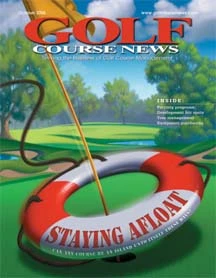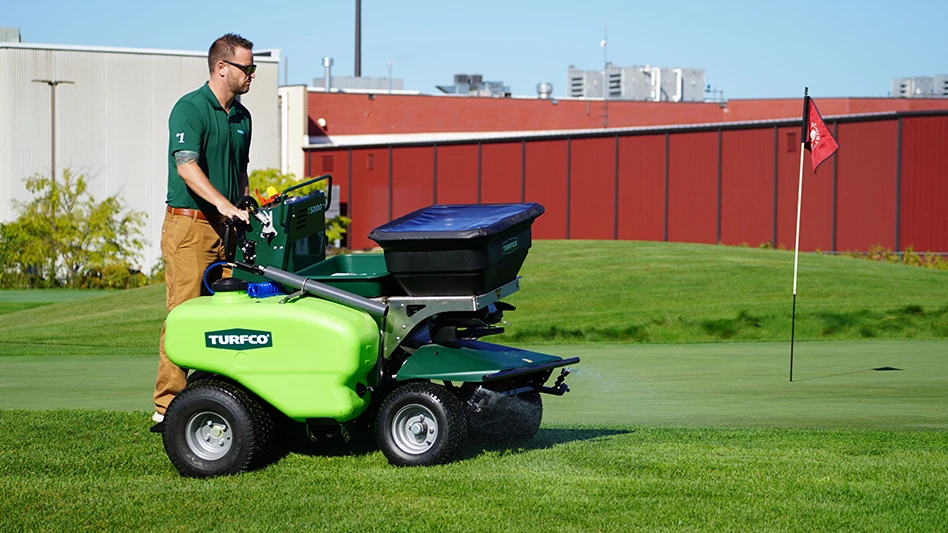Superintendents alter fertility programs to achieve balance
Just a few years ago, the “lean-and-mean” mantra dictated the greens fertility programs of many golf course superintendents. The amount of nitrogen used to fertilize greens was reduced, and at the same time, heights of cut were lowered. While the quest for ever-increasing green speed has driven Stimpmeter readings to 11 feet and faster, the consequences – often including increased turf stress and disease – have been less than desirable.
However, the pendulum is starting to swing the other way, says Bruce Clarke, Ph.D., director of the center for turfgrass science at Rutgers University in New Jersey.
“Five to six years ago, we began to see a significant increase in anthracnose on greens,” he says. “This was most likely the result of lower cutting heights and reduced amounts of nitrogen application. Where annual bluegrass is a major component of the putting surface, low mowing can deplete the carbohydrate reserves of this species, often already weakened by environmental stress. This told us that reduced fertility and ultralow cutting heights might not have been such a great idea.”
Todd Lowe, the U.S. Golf Association agronomist for the Florida region, sees a variety of fertility programs regularly. Some courses are lush, while others are lean, but most fall somewhere in between.
“As a whole, the industry is moving to more of a spoon-feeding program of applying nutrients on a lighter, more frequent basis,” he says. “This allows superintendents to provide the amount of nutrients they feel the turf needs. Also, the newer bentgrasses and Bermudagrasses are more prone to develop thatch.”
The most important cultural practice impacting thatch accumulation is nitrogen fertility, Lowe says, and applying a slug of nitrogen creates lush top-growth that must be worked harder to provide optimum playing conditions. It also can create friendly environments for pathogens.
Conversely, keeping the putting greens leaner provides better playing conditions on a more consistent basis, but it’s easy to go overboard and keep the greens anemic, Lowe says. It forces superintendents to manage greens on the edge as food reserves in the root system are used up. Often in these conditions, fungicides are applied more to protect the weakened plant.
It’s not the only way
Clarke, his Rutgers colleagues James Murphy, Ph.D., and graduate assistant John Inguagiato, have conducted research that shows mowing heights can be raised about 0.015 to 0.030 inch, and, with double mowing or single mowing in conjunction with rolling, will produce a green speed similar to that of a lower mowing height. The study demonstrates that lowering mowing heights isn’t the only way to obtain desired green speeds.
On the other hand, too much of a good thing can cause problems. Other research indicates that while rolling greens will increase green speed when done more than once a week, turfgrass wear might be a concern when rolling frequency is increased to more than three times a week.
Inguagiato is conducting research about the best management practices for controlling anthracnose and maintaining ball-roll distance. His preliminary results show that increasing mowing height from one-tenth inch or less to 0.125 inch or higher greatly reduced anthracnose. Furthermore, an acceptable ball-roll distance at a height of cut of 0.140 inch was obtained with a mowing frequency of 14 times a week and/or rolling every other day. The combination of double cutting and/or rolling at 0.125 or 0.140 inch also reduced the severity of anthracnose considerably.
Balance it out
At Cutten Club Golf & Tennis in Guelph, Ontario, Canada, the fertility program is designed to achieve a balance between playability and healthy turf. The push-up greens at the 75-year-old club are a mixture of Poa annua and bentgrass. Golf course superintendent David Kuypers tests the soil monthly, looking at nutrient levels, pH, organic matter and exchange capacities. Then he conducts a clipping analysis.
“Nitrogen is the nutrient everyone looks at,” he says. “I pay particular attention to the dry weight percentages of the clippings. For nitrogen, 4 to 6 percent is the textbook range. But to me, 6 percent is excessive; that would be very lush conditions.
Kuypers says he keeps the greens in the healthy range, but at the low end.
“We apply an adequate amount of nitrogen, but it’s not excessive,” he says. “On the other hand, we don’t starve the turf. Nitrogen is the only way plants will produce carbohydrates. All the stories that came out of the Northeast last year after their devastating summer pointed to carbohydrate starvation as the cause of the collapse of the plants. It’s just like a human being. If you starve yourself for a long time with poor nutrition and then there’s a stressful period in your life, you can collapse.”
Playability is another reason Kuypers stays in the lower end of nitrogen fertility.
“If there’s a target range, we’d rather be on the leaner end for control purposes,” he says. “We can always add more nitrogen if an issue comes up, such as a low growth rate. However, we can’t stop the grass if it’s going. Excess growth can be just as much a negative. We use short-residual, low-rate nitrogen in the spray tank. We monitor nitrogen levels weekly to make sure they’re adequate. We do a lot of tissue testing and alter our inputs based on the results.”
The goal at Cutten Club is to create the smoothest, truest surface possible. So Kuypers and his staff roll greens three times a week and use growth regulators. Kuypers also gives credit to Jacobsen’s E-Walk walking greens mower. The electric mower gives operators the ability to set clip frequency independent of walk speed.
“Every time you make a pass on a green, you’ll miss some blades,” Kuypers says. “That’s one reason some courses double cut. The longer the turf is on that first pass, the more you’ll miss, and the more impact that miss will have on ball roll. The more leaf tissue you try to cut off on any given day, the less clean the cut will be. If I want to affect green speed, changing the height of cut is the last thing I want to do. If we can get a good, clean cut on a healthy, dense stand of grass, speed takes care of itself. The E-Walks stand up the grass and provide a great quality of cut in one pass. We’re actually getting the same results as double cutting.”
This July in Guelph, the weather was hot with heavy rains, which created problems with summer patch. Extremes in nitrogen, high or low, make the plant more susceptible to this disease.
“If we are anywhere, it’s low, especially after a heavy rain,” Kuypers says. “Ammonium and magnesium sulfates are antagonistic to summer patch, so we came out with one-tenth of a pound of ammonium and knocked it down a bit. We raised the height of cut and took our medicine. The greens were a little slower, but they didn’t die. We didn’t have any turf loss from summer patch, which was key.
“Again, we want to find that balance of adequate growth and sufficient health, but not anything greater than that because it’s wasted,” he adds. “We can always increase fertility. Water and fertility programs are the two most important aspects of turf management. We pay a lot of attention to doing those things well. When you start to get lazy, the tendency is to overwater and overfertilize.”
Change with the times
Golf course superintendent John Cunningham has been involved in golf course maintenance for more than 30 years, and he realizes it’s easy to fall into a rut of doing things the same way. However, during the past six years, he’s changed his cultural programs based on changes in the industry.
“Today we maintain fairways like we used to maintain greens,” says Cunningham, who also serves as property manager for The Mandarin Golf & Country Club in Markham, Ontario, Canada. “Golfer expectations have changed, and we have to adjust our methods and cultural practices. Our goal is to determine the ideal green speed for our property and membership and then be consistent. It doesn’t matter what’s going on at courses down the road or up the street. We modified our program to better suit the Mandarin membership and make us more consistent on a day-to-day basis. When we approach the member/guest day, for example, we don’t have to dramatically ramp up conditions. We’re going to stay consistent.”
Cunningham tests soil annually and developed a foliar feeding program. He prefers foliar fertilizer because it’s applied on the leaves of the plant, which absorbs it.
“Foliar is a much more consistent application,” he says. “With granular, the operator has to walk at the same speed and take the same overlap. With foliar, we get a perfect application every two weeks, keeping the nitrogen level down so we don’t get a flush of growth. I can back off on the potassium, phosphorus or micronutrients and spoon feed whatever is necessary. We stick to the program for the season based on soil test results, then reevaluate in fall.”
The Mandarin, which opened in 1991, has bentgrass greens, tees and fairways. The greens were built to USGA specifications and are aerified once a year, in early September. At three-week intervals, they’re verticut and topdressed.
Water management is another critical element of Cunningham’s program. The staff is careful not to overwater and relies on hand-watering because the middle of the greens don’t need as much water as the edges.
“Members tell us the greens are smooth, consistent and true regardless of their speed, which can be slowed by topdressing,” Cunningham says. “That seems to matter most to members.”
A different focus
Despite the popular “lean-and-mean” mantra, Chris Hartwiger, USGA agronomist for the Southeast region, disagrees with its premise. He says that in his area, the southern end of the transition zone, green speed isn’t the focus.
“All the mid-level to high-end courses in this region have really good greens,” he says. “They have converted to more heat-tolerant bentgrasses, including A-1, A-4 and Crenshaw. There is a premium on keeping turf alive during summer. The rule isn’t to push green speed. No one is stealing market share over six inches of green speed. The difference is the ‘wow’ factor, which means exceeding customer expectations.”
The best example of the ‘wow’ factor in Hartwiger’s region is at the Atlanta Athletic Club. A few years ago, Rees Jones was brought in to renovate the Riverside Course, which received much less play than the Highlands Course, which hosted the 1976 U.S. Open and the 1981 and 2001 PGA Championships. The project included a new grassing scheme: Fairways are Zeon zoysiagrass, which has a fine leaf texture and light green color; and roughs are Tifton 10, a coarse Bermudagrass with a blue/green color.
“This represents a color and texture contrast,” Hartwiger says. “Golfers voted with their feet, and now more rounds are being played on the Riverside Course. Not to be outdone, the Highlands Course is being regrassed with Diamond zoysiagrass in the fairways, which has a very fine leaf blade, and Tifton 10 in the roughs. In this region, these factors take precedence over tweaking fertility programs.”
A degree of sanity
Yet fertility programs remain the heart and soul of playability and healthy turf. Clarke says the best programs are well balanced.
“It’s clear the best method for maintaining green speed and turf health is a program that includes raising the height of cut, using greens rollers and implementing a program of growth regulators,” he says. “This trend has brought back a degree of sanity to greens maintenance. It has heightened the awareness that mowing low isn’t the only way to achieve faster green speeds.” GCN
David Wolff is a freelance writer based in Watertown, Wis. He can be reached at dgwolff@charter.net.

Explore the October 2006 Issue
Check out more from this issue and find your next story to read.
Latest from Golf Course Industry
- Atlanta Athletic Club approves funding for master plan
- Maximizing Cultural Practices and Agronomic Benefits with Minimal Surface Disruption
- Real Answers about Spray Nozzle Choices
- From the Course to the Factory: How Customer Insights Drive Innovation
- New & Proven Enzyme Strategies for Sprayable Thatch Management
- Innovating Tomorrow: Wittek’s New Products & Industry Staples
- PBI-Gordon introduces new field development team
- The Cabot Collection announces move into course management






